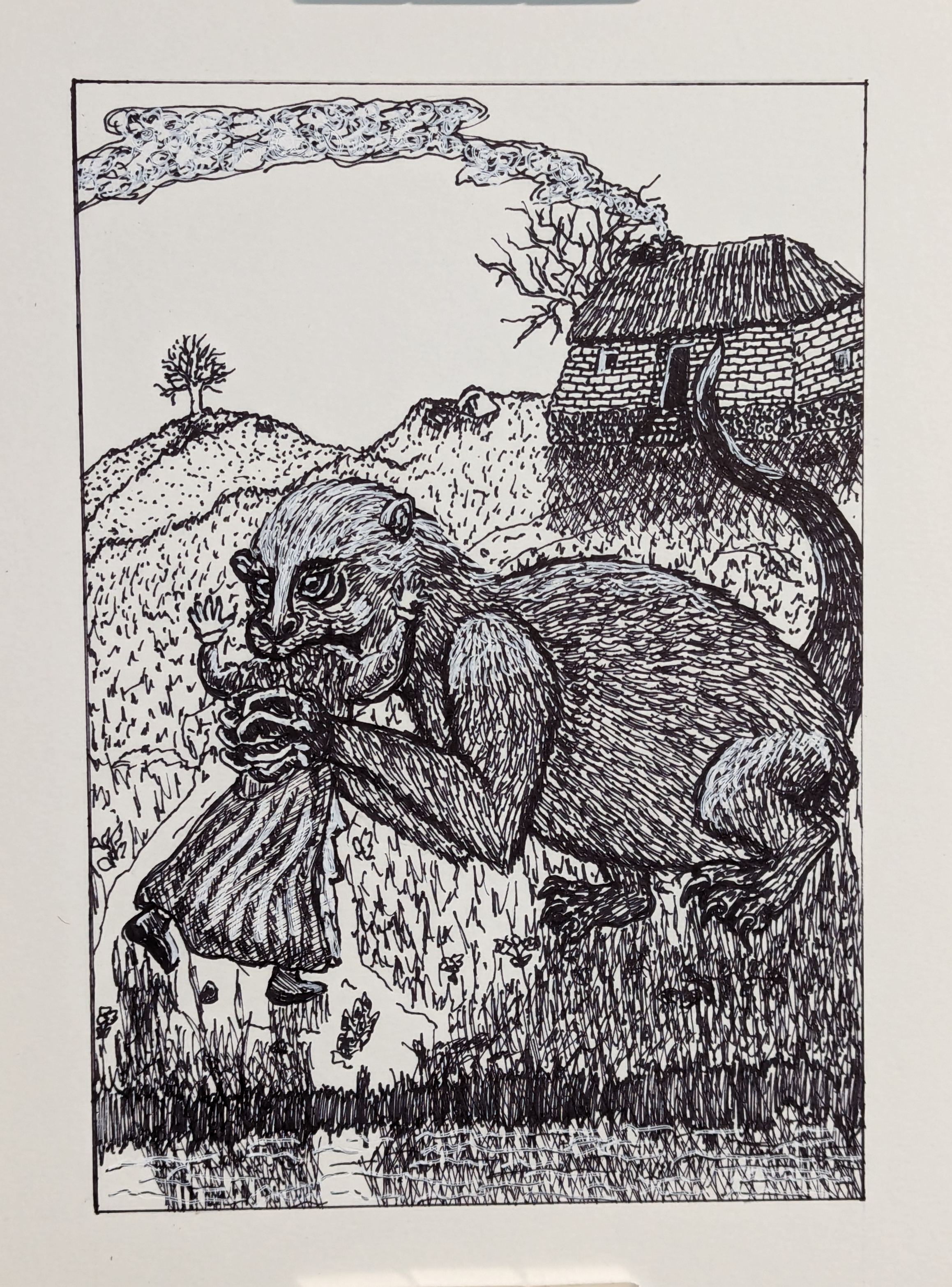The tale of Grace McGloighlin and the Dobhar-chú is a legendary story from Irish folklore, particularly associated with Glenade Lake in County Leitrim. This story is one of the most famous accounts involving the mythical creature known as the Dobhar-chú, also referred to as the “Water Hound” or “Water Dog.” Here is a recounting of the events as told through local lore:
The Legend:
Grace McGloighlin (sometimes referred to as Grace Connolly) lived near Glenade Lake in County Leitrim, Ireland. One day, while she was washing clothes by the lake, she was attacked by a Dobhar-chú. The creature, described as a fearsome, otter-like beast, brutally killed her. When Grace did not return home, her husband, Terence McGloighlin, went searching for her.
Discovery and Revenge:
Terence found Grace’s lifeless body near the lake, with the Dobhar-chú lying on top of her. In a fit of rage and grief, he attacked the creature and killed it. However, as the legend goes, the Dobhar-chú had a mate, and this second creature, equally ferocious, emerged from the lake to avenge its companion’s death.
The Pursuit:
Terence, fearing for his life, mounted his horse and fled, but the second Dobhar-chú gave chase. The pursuit is said to have been long and arduous, with Terence and the creature racing across the countryside. Eventually, Terence managed to kill the second Dobhar-chú as well, ensuring his survival and avenging his wife’s death.
The Grave and Memorial:
Grace McGloighlin’s grave can still be found in the Conwall Cemetery near Glenade Lake. The headstone, which has become a significant point of interest, features a carving that some believe depicts the Dobhar-chú. This gravestone is often cited as evidence of the legend’s authenticity, though it remains a piece of folklore.
Legacy:
The story of Grace McGloighlin and the Dobhar-chú is deeply embedded in local tradition and continues to be recounted as part of Ireland’s rich tapestry of myths and legends. While there is no scientific evidence to support the existence of the Dobhar-chú, the tale persists, blending elements of horror and heroism and maintaining its place in Irish cultural heritage.
Somber Realities
When I read this story, it makes me remember that violent people murder their spouses through physical abuse and lie about it on the regular. Not saying this is what happened here. I am sure no Irishman ever did such a thing. However, as that is a real thing, I want to drop a link for a group that fights these kinds of issues and then get back to the fun stuff.
Stop violence against women, any way you can. NOW.
Now here are the deets on the Dobhar-chú.
Regional Names:
- Ireland: Dobhar-chú, Water Hound, Water Dog
- Scotland: Otter King
Known Origin and Basic Lore:
- Origin: The Dobhar-chú is a mythical creature from Irish folklore, said to inhabit lakes and rivers.
- Lore: According to legend, the Dobhar-chú is a fearsome aquatic animal, often described as a cross between a dog and an otter. It is reputed to be extremely aggressive and dangerous, with stories often depicting it attacking and killing humans. One famous tale involves the creature killing a woman named Grace Connolly in the 17th century near Glenade Lake in County Leitrim.
Significant Sightings:
- Glenade Lake, County Leitrim: The most famous account involves the grave of Grace Connolly, which features an engraving of the Dobhar-chú, suggesting her death was caused by the creature.
- Lough Mask, County Mayo: There have been sporadic reports of sightings, though none have been conclusively proven.
Physical Description:
- Size: Approximately 5-7 feet in length.
- Appearance: Described as having the body of an otter, with some dog-like features. It has dark fur, often depicted as black or dark brown, and sometimes with a white patch on its chest.
- Eyes and Teeth: The creature is said to have large, menacing eyes and sharp teeth.
Behaviors:
- Aggression: Known for its aggressive behavior, especially when provoked or when its territory is encroached upon.
- Hunting: Primarily an aquatic predator, it is said to hunt fish and possibly larger prey, including livestock or humans.
- Social Structure: Often depicted as solitary or living in pairs, sometimes with the mate seeking revenge if one is killed.
Abilities:
- Swimming: Exceptional swimmer, capable of moving quickly and with agility in the water.
- Speed: Noted for its speed both in the water and on land, making it a formidable predator.
- Strength: Possesses great strength, enabling it to overpower larger animals and humans.
Preferred Habitat:
- Water Bodies: Prefers freshwater lakes, rivers, and streams, often in remote or less populated areas.
- Shelter: Likely to inhabit underwater dens or burrows along the banks of water bodies.
Range of Sightings:
- Ireland: Predominantly reported in western and northwestern regions, including counties Leitrim, Sligo, and Mayo.
- Scotland: Occasional reports from the Highlands and other rural areas.
Likelihood of Existence Based on Similar Species:
- Similar Species: The Dobhar-chú resembles large otters or other mustelids, such as the giant otter found in South America or the Eurasian otter native to Europe.
- Plausibility: While the folklore likely exaggerates certain features, the existence of a large, aggressive otter-like creature is within the realm of possibility. Historical accounts may stem from sightings of unusually large or aggressive otters, or misidentifications of other animals.
- Scientific Evidence: To date, there is no conclusive scientific evidence supporting the existence of the Dobhar-chú. Most accounts remain anecdotal, and no physical specimens have been found.
Conclusion: The Dobhar-chú remains a captivating element of Irish and Scottish folklore. While its existence is debated, it continues to be a part of the cultural heritage of the regions, inspiring curiosity and caution regarding the mysterious creatures that may lurk in the waters.
